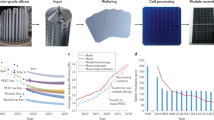Abstract
The growth and advancement of the electronic and photonic industry in the 21st century hinges on revolutionary new processing techniques that will overcome some of the most fundamental limitations of conventional methods. Rapid isothermal processing (RIP) based on incoherent radiation as the source of optical and thermal energy can play a major role in designing processing systems that offer the tight process control, low thermal budgets, low microscopic defects, high throughput and high yields required for almost every semiconductor device. Conventional RIP can be further optimized by fully exploiting the contribution of quantum photoeffects. The improved performance and reliability offered by RIP will make it the mainstream technology for the green manufacture of microelectronics, optoelectronics, solar cells, flat panel displays and microelectromechanical systems. Key issues related to the cost of ownership, design of RIP system based on the full utilization of photo–thermal effects and model based control systems are described. New experimental results for a number of processing steps are provided. These results demonstrate the importance of advanced RIP systems in providing better performance and lower defects for future devices.
Similar content being viewed by others
References
R. Singh, J. Appl. Phys., 63, R59–R114 (1988)
H. Kroemer, Quantum Mechanics, Prentice Hall, N.J., 5 (1994)
R. Singh, Electronics, 58, 19 (Dec 15, 1985)
R. Singh, Semiconductor International, 9(1), 28 (1986)
R. Singh, P. Chou, F. Radpour, A. J. Nelson, and H. S. Ullal, J. Appl. Phys., 66,2381 (1989)
R. Singh et. al., Appl. Phys. Lett., 58, 1217 (1991)
R. Singh, Proc. International Conference on Beam Processing of Advanced Materials, published by TMS, 619 (1993)
J. Mavoori et. al., Appl. Phys. Lett., 65, 1935 (1994)
R. Singh and R. P. S. Thakur, The Electrochem. Soc. Interface, 4, 28 (1995)
R. Singh, in Handbook of Compound Semiconductors, Noyes Publications, N.J., 442 (1995)
M. M. Moslehi et. al., Solid State Technology, p. 34 (Jan 1994)
K. G. Reid and A. R. Sitaram, Solid State Technology, p. 63 (Feb 1996)
D. L. Dance and D. W. Jimenez, Semiconductor International, 6, (Sept. 1995).
R. P. S. Thakur, Rapid Thermal Processing and ULSI Electronics, in Semiconductor Fab Tech., Spring 1996 (In Press)
K. G. Kemp, D. F. Frost and K. F. Poole, IEEE Trans. Reliability, 39, 26 (1990)
K. F. Poole, in Electronic Component Reliability, by F. Jensen, John Wiley & Sons, N.Y., chapter 11 (1995)
M. S. Moosa, K. F. Poole and M. L. Grams, Proc. 7th International Conference Quality in Electronic Components, France (1995)
R. Singh et. al., Mat. Res. Soc, Symposia proc., 224,197 (1991)
D. M. Dawson et. al., IEEE Trans. Control System Technol., 2, 233 (1994)
Z. Qu, J. F. Dorsey and D. M. Dawson, IEEE Trans. Automatic Control, 39, 2219 (1994)
J. J. Carroll and D. M. Dawson, IEEE Trans. Industrial Applications, 31, 248 (1995)
G.E. Jellison Jr., and F. A. Modine, J. Appl. Physics, 39(1), 3758 (1994)
P.J. Timans, J. Appl. Phys., 74(10) 6356(1993).
P. W. Atkins, Physical Chemistry, W.H.Freeman &Co., N.Y., 294, (1990).
P. Suppan, Principles of Photochemistry, Chemical Society, London, 6 (1973).
K. N. Tu, J. W. Mayer, and L. C. Feldman, Electronic Thin Film Science for Electrical Engineers and Materials Scientists, Macmillan Publishing Company, N.Y, 46, (1992).
A. E. Kiv and F. T. Umarova, Sov. Phys. Semicond., 7(9), 474, (1970).
T. Yamazaki, S. Watanabe, and T. Ito, J. Electrochem. Soc., 137(1), 313, (1990).
R. Sharangpani et. al., Mat. Res. Soc. Proc., 381,117 (1995)
R. Singh and R. Sharangpani, Proc. 2nd Int. Dielectrics for VLSI/ULSI Multilevel Interconnect Conf., 78(1996)
R. Singh et. al., IEEE Trans. Appl. Superconductors, 3, 1 (1993)
R. Singh, S. Alamgir and R. Sharangpani, Appl. Phys. Lett., 67, 3939 (1995)
Z. Chen, J. Appl. Phys., 74, 2856 (1993)
Y. Nissim et. al., Appl. Phys. Lett, 59, 656 (1991)
R. Sharangpani et. al., Proc. 8th Int. Conf. InP and Related Materials held at Schwabish Gmund, Germany (In Press), (1996)
Acknowledgments
The research reported here has been supported by DARPA (Low Power Electronics Program and High Temperature Superconductivity Program), Department of Commerce (Advanced Technology Program), National Science Foundation (EPSCOR Program) and APA Optics Inc. The technical support and encouragement of various program managers (Zachary Lemnios and Frank Patten of DARPA) and program monitors (Cynthia Hanson and Steve Russel of NCCOSC) is gratefully acknowledged. A number of graduate students and research associates have contributed most of the previously published results. During the course of this research we have interacted with a number of colleagues in industry, academia and government. It is not possible to mention all the individuals. In particular, the interaction with Joe Lorenzo of Hanscom Air Force Base, Asif Khan of APA optics Inc., A. Gat of AG Associates, Mehrdad Moslehi of CVC Products Inc., Pallab Chatterjee and Ashwini Shah of Texas Instruments, J. Narayan of NC State University, Hiroshi Iwai of Toshiba Corporation, A. R. Sitaram of Motorola and Y. Nissim of France Telecom is greatly appreciated.
Author information
Authors and Affiliations
Corresponding author
Rights and permissions
About this article
Cite this article
Singh, R., Sharangpani, R., Cherukuri, K. et al. How Rapid Isothermal Processing can be a Dominant Semiconductor Processing Technology in the 21St Century. MRS Online Proceedings Library 429, 81–94 (1996). https://doi.org/10.1557/PROC-429-81
Published:
Issue Date:
DOI: https://doi.org/10.1557/PROC-429-81




